When it comes to your business, one of your main goals (if not your biggest goal) is to make a profit. And to find profit, you may need to look at explicit and implicit costs. But, what exactly are these costs? And, what’s the difference between implicit vs. explicit costs? It’s time for your implicit and explicit cost rundown.
Implicit vs. explicit costs
Whether you realize it or not, you deal with both implicit cost and explicit cost while doing business. Implicit and explicit costs help you determine accounting profit and economic profit, opportunity cost, and more.
So, what is the difference between explicit and implicit cost? Let us walk you through it.
What are explicit costs?
Explicit costs, also known as accounting costs, are normal business expenses that appear in the general ledger. These costs can directly affect your business’s profitability.
Accounting costs involve tangible assets and monetary transactions. Explicit cost examples include:
- Employee wages
- Lease payments
- Utilities
- Raw materials
- Advertising
- Supplies
- Rent
- Other direct costs
Accounting costs are generally easy for business owners to identify, track, and record. You can use explicit costs to calculate your company’s profit and see where you need to make changes when it comes to expenses.
What are implicit costs?
Implicit costs are a little more complicated than explicit costs. Whereas explicit costs are more straightforward, implicit costs deal with intangible costs.
An implicit cost represents an opportunity cost. Unlike explicit costs, implicit costs are the costs associated if you would do something, like make an investment.
With implicit costs, you do not track them like business expenses in your books. Instead, you can calculate implicit costs to determine economic profit and help make smart business decisions.
Basically, implicit opportunity cost comes from the use of an asset instead of a purchase or rental of an asset. Check out a few implicit cost examples:
- Annual cash flow from stocks if you sold your business
- Payments you would earn from a rented property
- Time spent on one business activity that could better be spent on a different task
- Business owner passing on taking a salary in the early stages of operations
- Time equipment is offline for maintenance
Calculating explicit cost vs. implicit cost
Now that you have some background information on explicit vs. implicit costs, let’s take a look at how to calculate explicit cost and implicit cost for your business.
Calculate explicit cost
Calculating explicit costs is simple as long as you know your business expenses. To calculate explicit costs, add together your business expenses on the general ledger. Again, this could include insurance, rent, equipment, supplies, cost of goods sold, etc.
Keep in mind that expenses vary from business to business. So, there is no universal formula for computing explicit costs. But, it’s pretty easy to compute if you have a list of your business expenses at the tip of your fingers.
Explicit cost example
Say your business has $10,000 in cost of goods sold, $1,000 in rent, $200 in supplies, $300 in insurance, $13,000 in employee wages, and $500 in utility costs for the period. To find your total explicit costs, add together all of your expenses:
Explicit Costs = $10,000 + $1,000 + $200 + $300 + $13,000 + $500
Your total explicit costs add up to $25,000 for the period. You can plug this amount into other formulas, like the accounting or economic profit formulas, to find out financial information for your business.
Want to impress your friends at a dinner party?
Get the latest accounting news delivered straight to your inbox.
Subscribe to Email ListCalculate implicit cost
Essentially, implicit cost represents an opportunity cost when a company uses resources for one decision over another. Because it can involve various types of situations, it’s hard to give an implicit cost calculation a standard formula.
To find your implicit or opportunity cost of a situation, take a look at the costs associated with an opportunity. For example, a day spent training a new employee means another employee misses out on sales and commission. That opportunity cost (aka the commission and other pay) is an implicit cost for the employee/trainer.
Implicit cost example
Say you’re a new business owner who just started your first company a few years ago. To help pay for startup expenses, you decide not to take a salary for the first two years. Your salary would have been $60,000 per year.
Because you did not receive a salary for two years, your implicit cost for your decision is $120,000 ($60,000 X 2). If you would have received said salary, it would have been an explicit cost instead.
This is not intended as legal advice; for more information, please click here.
